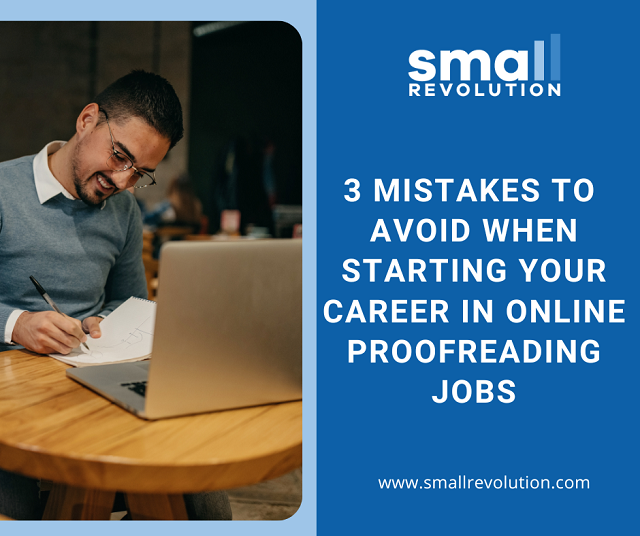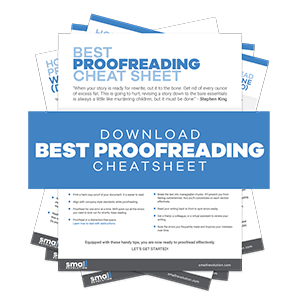Imagine beginning your career in proofreading and not making any mistakes. You continue with this trajectory and one client after the other leaves you a positive review.
The accumulated positive reviews make you one of the most sought-after proofreaders in the market. You no longer look for proofreading jobs, clients are overwhelmingly looking for you.
How does this happen?
Well, for a proofreader, It happens when you succeed in the following areas:
- The basics of proofreading
- Professional development
- Marketing
Small Revolution provides all the information you need for your online proofreading job.
Proofreading is a career that requires skills more than education. You can only become an expert proofreader by sharpening your skills.
So how do you sharpen your skills, yet you are just starting?
Fortunately, there is a solution. Just avoid the following mistakes.
1: Not Knowing the Basics of Proofreading

Proofreading seems like an easy task. After all, you only have to remove errors related to word choices, punctuation, grammar, spacing, formatting, and spelling.
It’s not that easy.
Novice proofreaders often miss at least one of these errors. You have to learn a few basics when proofreading to avoid missing any errors.
These basics include:
- Reading your material out loud. This engages multiple senses of your body. When you hear the written words, you get a better sense of their rhythm and flow of ideas.
You can also use a free text-to-speech reader. It will help you notice mistakes that your mind wouldn’t make. For example, your mind may automatically skip a repeated word. A text-to-speech reader won’t.
- Printing your material. Take a break from all the screen time and read your material from a printed copy. When your eyes are rested from constantly looking at your screen, you have a better chance of noticing more errors.
- Leaving your material for a while before proofreading. Proofreading requires a rested mind for your full attention. Rest for an hour or two before you start proofreading.
Additionally, you can set a plan where you proofread different aspects at different intervals. Start by reading your material out loud to adjust its rhythm and flow of ideas. Rest for an hour and then check your material again for punctuation, spacing, and spelling errors.
After leaving your material, printing, and reading it out loud, there are still chances of missing some errors. After all, you are human.
The solution is to use proofreading tools.
Proofreading Tools
Proofreading tools can help you notice errors you would have otherwise not noticed.
Especially for a novice proofreader, you may have some awkward word choices, improper punctuation, or minor spelling mistakes.
Proofreading tools will point out these mistakes, but will not always be right. Therefore, only use them sparingly.
Some of the most common tools include:
- Grammarly. Install the latest Grammarly extension in your browser. It will help you check for punctuation, spacing, spelling, and grammatical errors.
- Hemingway App. Copy and paste your work onto the Hemingway App’s website. It will make your work more readable.
- Quillbot. Copy and paste your work onto Quillbot or install the latest browser extension. It will point out some awkward or complex sentence structures.
- ChatGPT. Copy and Paste your work onto this artificial intelligence tool and it will help you proofread. ChatGPT can perform several functions. It can help you point out awkward writing, eliminate grammatical errors, and create rhythm in your work.
Just follow the steps outlined in the video below.
You must be wondering, why should I do the proofreading myself when there are a variety of tools? Well, the table below outlines when you can use each tool and where it could fail you.
| Tool | Usefulness | Weakness |
| Grammarly | Checks grammar, punctuation, formatting, and spelling | Often suggests the wrong words and misses some errors |
| Hemingway App | Reduces the complexity of your work | Often misses some errors |
| ChatGPT | Improves your sentence structure and checks for grammatical errors | Often suggests the wrong words |
| Quillbot | Reduces the complexity and awkwardness of your sentences | Often suggests wrong sentence structures |
Pro Tip: All the mentioned tools will trigger AI detection tools. Only use them as a complementary method of proofreading.
2: Ignoring Professional Development

Everybody can be a proofreader, but not everybody has the skills to be an expert.
Proofreading is a profession that requires skills more than education. Nevertheless, Small Revolution provides all the information you need to learn about proofreading.
Just like a swordsman continuously sharpens their sword, you need to constantly build a strong professional network.
Build a Strong Professional Network

No man is an island. In the same way, no proofreader is an island. You need a strong network of both proofreaders and proofreading clients.
A strong professional network will help you stay in the loop whenever there are new developments in the proofreading industry.
It will support you and help you find work. For example, when a high-value client with abundant tasks appears, your network will inform you and share a piece of the cake.
These steps will help you get started:
- Choose who you want to network with. Do you want to connect with clients or other freelance proofreaders, or both? Your choice will determine how you approach networking.
- Use your contacts to make new connections. Dig deeper into your existing contacts. Advertise your new career path to your friends and family. Soon, you will realize that you already have a network behind you.
- Use social media. Take some time to rebrand your social media profiles. If possible, set up separate work profiles to connect with clients. Social media is the best tool for establishing networks.
- Attend networking events in person. Always look out for events where you can meet potential clients. Events involving writers are the best to meet both clients and proofreaders.
- Join a proofreading society. An example of a proofreading society is the Chartered Institute of Editing and Proofreading.
That’s not all. To quantify your professional development, build a strong portfolio.

Build a Strong Portfolio
Clients rely on your portfolio to determine whether you are a good proofreader. A strong portfolio outlines your experience, value, and referrals from previous clients.
The process of building a strong portfolio requires patience and a good grasp of what your clients need.
If you follow the tips outlined in this table, you will build a very strong portfolio.
| Tip | Procedure |
| Offer your service for free | Build your portfolio with reviews from your initial clients. This may require offering your service in exchange for reviews for your first clients |
| Focus on being of service | Always focus on what the client wants and try to solve their problems before they ask |
| Create a checklist | A proofreading system and checklist will make it easier for you and your client to agree on requirements |
| Take your time | Like most businesses, your proofreading portfolio will require patience and time to develop |
| Start with small projects | As a beginner, look for small proofreading projects first. As your portfolio grows, move to larger projects such as dissertation editing, scientific editing, and novel editing |
3: Failure to Market Yourself Effectively
Product is what you believe, marketing is how you get other people to believe it.
Jack Butcher
There are already thousands of other proofreaders in the market. When you market yourself effectively, you make it easier for high-value clients to notice your talent.
Even the most experienced proofreaders spend most of their time marketing their skills.
Small Revolution suggests a direct approach as the best marketing strategy.
A direct approach involves the following:
- Listing all the clients hiring proofreaders
- Proofreading a section of their content and including it in your application sample
- Collecting their email addresses and pitching your services
Now, this is important. You must establish a competitive rate and communicate with your clients clearly if you want the clients to respond.
Establishing a Competitive Rate
It is possible to earn a decent income in the online proofreading market. Therefore, don’t undersell yourself just because you are a beginner.
Always ensure your rates match the current market standards for a competitive rate.
According to Small Revolution, clients can charge per word, per project, or hourly. Charging per hour reduces the complexities of determining the total value.
As you gain experience, you can switch to charging per page.
Follow Payscale and charge your proofreading clients between $20 and $35 per hour.

When you have established the number of words, or size of the project you can complete in an hour, adjust your charges to match the charges per hour.
For example, if you charge $20 per hour, charge $20 for the number of words you can write in an hour.
Clear Client Communication

Like most professions, the client is always right in online proofreading jobs.
When you clearly communicate with your clients, you avoid missing any of their requirements.
Sometimes, the client may find it difficult to communicate their needs. This is especially when they have never dealt with a proofreader before.
Case in point, a client may request you to increase the line and paragraph spacing on their task. Without specific spacing parameters, you may end up including too much spacing.
To assist the client in communicating their needs better, ask them to do the following:
- Explain the context of their material
- Be specific about what they want
- State what they like and what they dislike
- Be honest and open-minded
After Avoiding the Mistakes, What Next?
Online proofreading is a job you can do both full-time and part-time.
After learning proofreading basics, developing your profession, and marketing yourself effectively, you can earn good money from it.
Small Revolution will guide you all the way from learning about proofreading, finding a proofreading job online, and avoiding the most common mistakes made by beginning proofreaders.
Share on Facebook:



